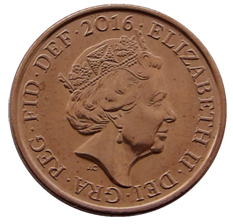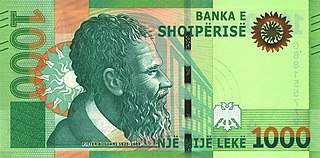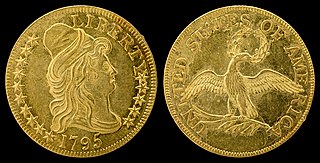
The cent, the United States one-cent coin, often called the "penny", is a unit of currency equaling one one-hundredth of a United States dollar. It has been the lowest face-value physical unit of U.S. currency since the abolition of the half-cent in 1857. The first U.S. cent was produced in 1787, and the cent has been issued primarily as a copper or copper-plated coin throughout its history. Due to inflation, pennies have lost virtually all their purchasing power and are often viewed as an expensive burden to businesses, banks, government and the public in general.

The British decimal one penny (1p) coin is a unit of currency and denomination of sterling coinage worth 1⁄100 of one pound. Its obverse featured the profile of Queen Elizabeth II since the coin's introduction on 15 February 1971, the day British currency was decimalised until her death on 8 September 2022. A new portrait featuring King Charles III was introduced on 30 September 2022, designed by Martin Jennings. Four different portraits of the Queen were used on the obverse; the last design by Jody Clark was introduced in 2015. The second and current reverse, designed by Matthew Dent, features a segment of the Royal Shield and was introduced in 2008. The penny is the lowest value coin ever to circulate in the United Kingdom.

The British decimal two pence coin is a denomination of sterling coinage equalling 2⁄100 of a pound. Since the coin's introduction on 15 February 1971, the year British currency was decimalised, its obverse has featured four profiles of Queen Elizabeth II. In 2008 the design on its reverse changed from the original depiction of a plume of ostrich feathers with a coronet to a segment of the Royal Shield.

The half farthing was a British coin worth 1⁄1920 of a pound, 1⁄96 of a shilling, or 1⁄8 of a penny. The coins were minted in copper for use in British Ceylon in various years between 1828 and 1856, and as a bronze proof coin in 1868. In 1842, they were also declared legal tender in the United Kingdom. Half farthings were demonetised along with all other British copper coins on 31 December 1869.

The British penny, a large, pre-decimal coin which continued the series of pennies which began in about the year 700, was struck intermittently during the 20th century until its withdrawal from circulation after 1970. From 1901 to 1970, the obverse of the bronze coin depicted the monarch who was reigning at the start of the year. The reverse, which featured an image of Britannia seated with shield, trident, and helm, was created by Leonard Charles Wyon based on an earlier design by his father, William Wyon. The coins were also used in British colonies and dominions that had not issued their own coins.

The British farthing abbreviated qua., was a denomination of sterling coinage worth 1/960 of one pound, 1/48 of one shilling, or 1/4 of one penny; initially minted in copper and then in bronze, which replaced the earlier English farthings. Before Decimal Day in 1971, Britain used the Carolingian monetary system, wherein the largest unit was a pound sterling of 20 shillings, each of 12 pence. Each penny was divided into 4 farthings, thus, a pound sterling contained 960 farthings, and a shilling contained 48 farthings. From 1860 to 1971, the purchasing power of a farthing ranged between 12p and 0.2p in 2017 values.

The lek is the currency of Albania. Historically, it was subdivided into 100 qintars.

A nickel is a five-cent coin struck by the United States Mint. Composed of cupronickel, the piece has been issued since 1866. Its diameter is 0.835 inches (21.21 mm) and its thickness is 0.077 inches (1.95 mm).

The dime, in United States usage, is a ten-cent coin, one tenth of a United States dollar, labeled formally as "one dime". The denomination was first authorized by the Coinage Act of 1792.
The British farthing was a British coin worth a quarter of an old penny. It ceased to be struck after 1956 and was demonetised from 1 January 1961.

The United States large cent was a coin with a face value of 1/100 of a United States dollar. Its nominal diameter was 11⁄8 inch (28.57 mm). The first official mintage of the large cent was in 1793, and its production continued until 1857, when it was officially replaced by the modern-size one-cent coin.
The coins of Canada are produced by the Royal Canadian Mint and denominated in Canadian dollars ($) and the subunit of dollars, cents (¢). An effigy of the reigning monarch always appears on the obverse of all coins. There are standard images which appear on the reverse, but there are also commemorative and numismatic issues with different images on the reverse.

The 1 euro cent coin (€0.01) has a value of one hundredth of a euro and is composed of copper-covered steel. It is the lowest-value coin in the Eurozone, the next highest are the 2 and 5 euro cent coins. The coins of every Euro country have a common reverse and each has a country-specific (national) obverse. The coin has been used since 2002 and was not redesigned in 2007 as was the case with the higher-value coins.

The 2 euro cent coin (€0.02) has a value of one-fiftieth of a euro and is composed of copper-plated steel. All coins have a common reverse and country-specific (national) obverse. The coin has been used since 2002 and was not redesigned in 2007 as were the higher-value coins.

The 5 euro cent coin (€0.05) has a value of one twentieth of a euro and is composed of copper-covered steel. All coins have a common reverse and country-specific (national) obverse. The coin has been used since 2002 and was not re-designed in 2007 as was the case with the higher-value coins.

The half eagle is a United States coin that was produced for circulation from 1795 to 1929 and in commemorative and bullion coins since 1983. Composed almost entirely of gold, its face value of five dollars is half that of the eagle coin. Production of the half eagle was authorized by the Coinage Act of 1792, and it was the first gold coin minted by the United States.

The Australian pre-decimal halfpenny coin, commonly known as a ha’penny, was the smallest denomination of the Australian Pound in circulation. It was a unit of currency that equalled half of a penny, 1/24 of a shilling or 1/480 of a pound. The coin was made to be equivalent to the British halfpenny; its dimensions, composition and values were equivalent, and additionally, the two currencies were fixed at par.

The Lincoln cent is a one-cent coin that has been struck by the United States Mint since 1909. The obverse or heads side was designed by Victor David Brenner, as was the original reverse, depicting two stalks of wheat. The coin has seen several reverse, or tails, designs and now bears one by Lyndall Bass depicting a Union shield. All coins struck by the United States government with a value of 1⁄100 of a dollar are called cents because the United States has always minted coins using decimals. The penny nickname is a carryover from the coins struck in England, which went to decimals for coins in 1971.

The five-sentimo coin (5¢) coin is the second-lowest denomination coin of the Philippine peso after the one sentimo.
5 Lekë have a value of 5 Albanian lek and is composed of a nickel-covered steel. The coin has been used since 1939 and has been redesigned several times, while also being printed as a banknote for the years 1942-1944 during the Italian occupation of Albania.
















